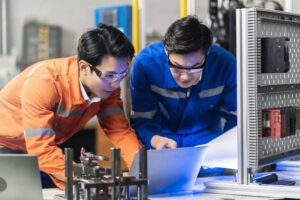It’s human nature to learn, evolve, and improve. Since the beginning of time, we have progressed to a better future. Humans have come a long way from using stones to create fire to telling a virtual assistant to turn on or off the electrical equipment. Some will say machines have taken over and bots have replaced humans — but we’re the ones steering this ship.
Whether you follow the latest trends, you may have heard about artificial intelligence (AI) and machine learning (ML). We use these technologies every day, but what exactly are they? Are they two names for the same technology? In this blog, I explain AI and ML and their value for manufacturers.
What is artificial intelligence?
Enabling a machine to simulate human behavior is called artificial intelligence. When a machine becomes smart, it can understand a command, store and connect data, and draw conclusions. The idea behind AI is to make a smart system human-like to solve complex problems. AI is divided into three categories — weak AI, general AI, and strong AI — based on system capabilities.
Benefits of artificial intelligence
- Enhanced productivity: Artificial intelligence automates repetitive tasks, freeing up human resources for higher-value work.
- Increased efficiency: AI algorithms process data faster and more accurately than traditional methods.
- Improved decision-making: AI provides data-driven insights, leading to better strategic choices.
- Cost reduction: Streamlined operations and reduced errors lower operational costs.
What is machine learning?
Machine learning is a subset of AI which allows a machine to learn from past collected data without programming explicitly. Methods like neural networks, statistics, operations research, and physics are used to find hidden insights in the data. ML allows machines the direct data access to learn from the results to provide better decisions in the future.
A neural network is a computer system designed to work by classifying information the same way a human brain does. It can be taught to recognize, for example, images, and classify them according to elements they contain.
Machine learning is divided into three categories: supervised learning, unsupervised learning, and reinforcement learning.
How artificial intelligence can boost productivity
The smart manufacturing revolution enables manufacturers to produce more, higher-quality products at a reduced cost more successfully than ever before. One of the core technologies driving this latest innovation is industrial artificial intelligence. With the boom in cloud computing and big data storage and analysis, artificial intelligence helps improve efficiency in manufacturing environments, leading to better performance and results.
Here are six ways how AI is improving manufacturing.
1. Meticulous forecasting
Using AI and machine learning, systems can test hundreds of mathematical models of production and outcome possibilities, and be more precise in their analysis and results. This is done while adapting to new information such as new product innovations, supply chain disruptions, or sudden changes in demand. According to McKinsey, machine learning can reduce inventory by 20 percent to 50 percent.
2. Predictive maintenance
Sensors can track the conditions of equipment and analyze the data on an ongoing basis. The technology enables machines to evaluate their own conditions, order replacement parts, and schedule a field technician when needed. Taking predictive maintenance one step ahead, algorithms based on big data can predict future equipment failures. McKinsey found that AI-enhanced predictive maintenance of industrial equipment can reduce maintenance costs by 10 percent, downtime by 20 percent, and inspection costs by 25 percent.
3. Hyper-personalized manufacturing
With innovations in AI, software intelligence enables companies to take personalization to the next stage by making products and services that are highly relevant to individual consumers. This is crucial for today’s businesses because personalization sells. In a recent survey, 20 percent of consumers said that they would be willing to pay a 20 percent premium for personalized products or services. According to Accenture, 83 percent of consumers in both the U.S. and U.K. are willing to have trusted retailers use their personal data in order to receive tailored and targeted products, recommendations, and offers.
4. Automated material procurement
Analytics combined with machine learning will record and critique everything, including the beginning stages of quoting and establishing the supply chain. McKinsey predicts machine learning will reduce supply chain forecasting errors by 50 percent and reduce costs related to transport and warehousing and supply chain administration by 5 to 10 percent and 25 to 40 percent, respectively.
5. Increased efficiency
Schneider Electric™ created a predictive IoT analytics solution based on Microsoft Azure Machine Learning service and Azure IoT Edge to improve worker safety, minimize costs, and achieve sustainability goals. Data scientists at Schneider use information from the oil field to build the models that predict when and where maintenance is required. They then use the automated machine learning capabilities to intelligently select the optimal machine learning models and automatically tune machine model hyperparameters to save time and improve efficiency.
When the company deployed the Azure Machine Learning service-based solution, it helped operators increase efficiency by 10 to 20 percent in just two days. Learn more about those results here.
6. Quality control
BMW uses AI to evaluate component images from its production line, allowing it to spot, in real-time, deviations from quality standards. In the final inspection area at the BMW Group’s Dingolfing plant, an AI application compares the vehicle order data with a live image of the model designation of the newly produced car. If the live image and order data don’t correspond, for example, if a designation is missing, the final inspection team receives a notification.
The points listed above are just a few examples on how artificial intelligence is improving our lives on daily basis. And they’re just the beginning. According to a recent report from Research and Markets, the AI market is expected to grow at a compound annual growth rate (CAGR) of 52 percent from 2017 to 2025. For many manufacturers, this translates to improved production efficiency and increased capacity.
To continue reading about AI and its role in our world, I invite you to check out this blog.



